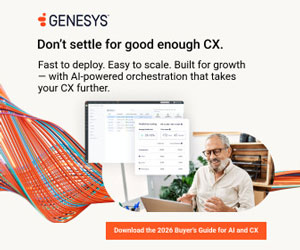The cost savings of self-service have long been a focus for banks, but a “big picture” viewpoint begs the question: What’s the lost revenue risk from not having in-person discussions? It’s a critical balancing act that’s becoming more complex as the banking industry evolves.
Banks want to improve engagement with customers and keep them around for the long term. That requires insights gleaned from many data sources, much of it stored in disparate systems and then ported into other data repositories.
It’s hard work to make it actionable, especially to track and orchestrate customer journeys. While data can be accessed when customers engage, and you can add input from third-party data sources, you might be missing the more nuanced long view of the customer journey.
Understanding Customers at Micro and Macro Levels
Micro-journey analytics — knowing where customers are on their current journey and what they are calling about — empower traditional contact centre agents.
In contrast, wealth managers and brick-and-mortar branch bankers achieve their goals when they have insights into the macro-level journeys that reveal long-term growth opportunities for very specific customer profiles.
These macro-level analytics now leverage machine learning algorithms and go beyond simple rules-based customer profiles.
While there have always been micro- and macro-level analytics, they usually didn’t mix. Developing the capability to share that data has been very costly or labor-intensive.
Today, all customer-facing roles need micro- and macro-level journey data analytics to drive their success, especially for results-oriented predictive engagement.
One reason for this trend is that the walls are coming down between previously siloed employees like contact centre agents and brick-and-mortar bankers. They’re now using the same technologies to engage with customers — and roles are beginning to overlap.
As self-service solutions increasingly answer easier questions, live-person interactions are becoming more sophisticated and challenging.
The traditional roles of bank employees are changing. This means that micro- and macro-analytics must become ubiquitous, allowing bankers and agents to view the client through different lenses.
Data Is Plentiful; the Right Data Isn’t
There’s no lack of data. Banks can find out who lives within a 10-square-mile radius of a postcode; who’s going to be wealthy in 10 years; and so on. But accessing that data has required cumbersome analytics exercises, usually done for one-off marketing campaigns.
But others in the organization often don’t see this data in real time. That’s one of the problems of having disconnected systems, and it creates customer experience problems with root causes that are hard to pinpoint.
Next-generation analytics platforms need to give you a view of customer profiles and segments across different axes, predicting behavior across time and identifying opportunities that can be realized — regardless of engagement channels.
Many of these platforms use “no code” development tools, providing simple drag-and-drop interfaces to develop very sophisticated views. This enables a superuser from the business side to build advanced capabilities without engaging developers and engineers.
Ideally, your no-code/low-code analytics platform will also natively feed into your real-time engagement system.
The Contact Centre Is Evolving
Contact centres can use predictive engagement to automatically offer a chatbot or an agent for a chat — or even a callback during a moment of truth. Typically, these micro-level journeys aren’t connected in a way that supports a macro-focused goal of building lifetime value.
This tactical approach doesn’t account for the potential lifetime value of a client or prospect. Even if you can feed third-party data into decision engines, they’re often focused on micro journeys. As an example, you might lack insight as to whether the client should be served a bot or a live agent who’s highly skilled at retention.
Macro-level metrics need to be part of real-time decision engines so you don’t risk churn for a client who has a high lifetime value. With a micro-only view, it’s hard to make a “big picture” decision because your analytics are based on a narrow decision window.
Strategies to Win
Companies are partnering to provide a true end-to-end solution that blends micro and macro journeys.
Conclusion
Competition is forcing banks to reevaluate their core operating models. Regardless of how they evolve — whether it’s purely digital, brick and mortar, or a hybrid solution — understanding customers’ micro- and macro-level journeys remains a key to success.
It’s only with these types of sophisticated insights that banks can successfully blend automation with human-assisted service to deliver actionable empathy — at scale.
This blog post has been re-published by kind permission of Genesys – View the Original Article
For more information about Genesys - visit the Genesys Website
Call Centre Helper is not responsible for the content of these guest blog posts. The opinions expressed in this article are those of the author, and do not necessarily reflect those of Call Centre Helper.
Author: Genesys
Published On: 17th May 2022
Read more about - Guest Blogs, Genesys






 Genesys empowers more than 8,000 organisations in over 100 countries to improve loyalty and business outcomes by creating the best experiences for their customers and employees. Through Genesys Cloud, the AI-Powered Experience Orchestration platform, Genesys delivers the future of CX to organisations of all sizes so they can provide empathetic, personalised experience at scale. As the trusted platform that is born in the cloud, Genesys Cloud helps organisations accelerate growth by enabling them to differentiate with the right customer experience at the right time, while driving stronger workforce engagement, efficiency and operational improvements.
Genesys empowers more than 8,000 organisations in over 100 countries to improve loyalty and business outcomes by creating the best experiences for their customers and employees. Through Genesys Cloud, the AI-Powered Experience Orchestration platform, Genesys delivers the future of CX to organisations of all sizes so they can provide empathetic, personalised experience at scale. As the trusted platform that is born in the cloud, Genesys Cloud helps organisations accelerate growth by enabling them to differentiate with the right customer experience at the right time, while driving stronger workforce engagement, efficiency and operational improvements. 












